I'm a basketball history buff. Come share my passion. @Basketball.101 on Instagram.
Don't wanna be here? Send us removal request.
Text
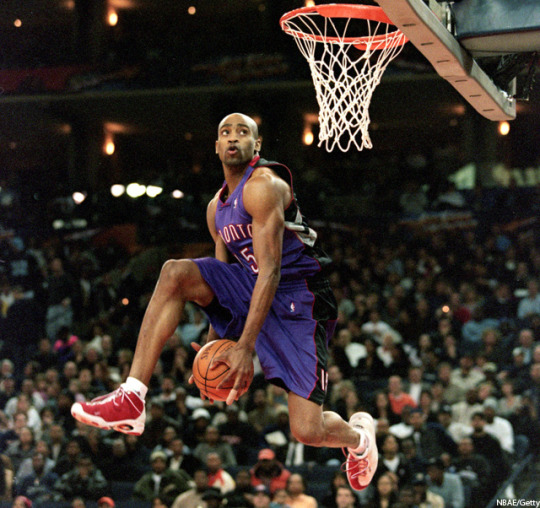
An homage to the man who saved the Slam Dunk Contest.
Long-gone were the days when the league’s ‘A-List’ stars competed in the exhibition. With the starpower gone, the contest had been reserved for end of the bench players and young highflyers looking to make a name for themselves. Performing unoriginal dunks and leaving no lasting memories for the fans. And for the two years prior to 2000, the contest had been left for dead - being replaced by the WNBA-NBA 2Ball Contest in ‘98 and no All-Star Weekend entirely in ‘99 due to the lockout.
There was a genuine itch for the return of the contest during All-Star Weekend in 2000. Helping hype that itch was a group of young, high-flying blue chippers set to compete. Not quite the starpower that once bestowed the exhibition - but young stars with bright futures ahead of them.
Tracy McGrady and Steve Francis threw down slams that would have easily clinched them gold in any other year. But the night belonged to Vince Carter.
Carter established dominance early with a strong 360 windmill dunk to start. He followed it up with a 180 reverse slam, where he started underneath the backboard. The crowd had no idea how to process these dunks.
Carter’s third dunk was where he showed the world he was on a different level and why he was called “Half Man, Half Amazing.” He caught a bounce from teammate Tracy McGrady, put the ball between his legs mid-air, and finished with a thunderous windmill.
Carter cruised to the finals; but by now everyone knew the contest belonged to ‘Air Canada.’ Carter flashed his elite vertical with a one-handed jam where his entire forearm was in the basket. He hung onto the rim for a few extra seconds for dramatic effect. He finished off the night with a “safe” two-handed slam from about 13 feet out.
Carter won the contest going away and ‘Vinsanity’ had officially begun. His performance ascended his career and the dunk contest itself to new heights, while simultaneously putting Canadien basketball on the map.
Carter showed the world why he was “Half Man, Half Amazing.” I salute you, Vince Carter. Thanks for the memories.
#slam dunk contest#dunk contest#all star weekend#nba all star#nba all stat 2020#nba#slam dunk#vince carter#half man half amazing#vinsanity
6 notes
·
View notes
Photo
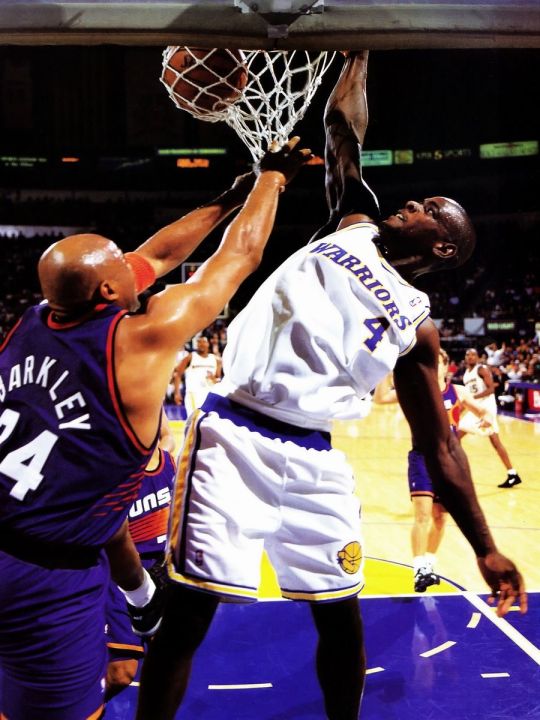

In a 1993 home game against the Phoenix Suns, a rookie Chris Webber received an outlet pass on the break from Latrell Sprewell. C-Webb flashed an around-the-back move (with no one around him) before rising for the flush. In the air, he met Phoenix’s Sir Charles Barkley and proceeded to dunk on his head.
The dunk brought the house down. The future was bright in Golden State.
Nike decided to capitalize on this youth movement, and filmed a commercial for their Barber Shop series with C-Webb and Spre recounting and re-enacting the sequence. At the end, Webber made a remark that probably didn’t sit well with Chuck, saying “He (Barkley) said, I don’t believe in role models, but you mine.”
Barkley was not about to get shown up by anyone like that, let alone from a rookie. When the two teams met in the playoffs later that year, Barkley turned it up a few notches averaging 37 points on 60% shooting for the series. In the final game, Barkley dropped 56-14 while regularly taunting the Warriors’ bench saying, “Put that in a commercial.”
3 notes
·
View notes
Text
Scenes from the first dunk contest at the 1976 ABA All-Star Game in Denver. Featuring Julius Erving, David Thompson, George Gervin, Larry Kenon, and Artis Gilmore.
This was far from the dunk contest we’ve come to know in 2020. The contest happened during half-time of the All-Star Game. It was one round and each player was given two minutes to perform five different dunks. The judges awarded points for artistic ability, imagination, body flow, and, most importantly, fan response.
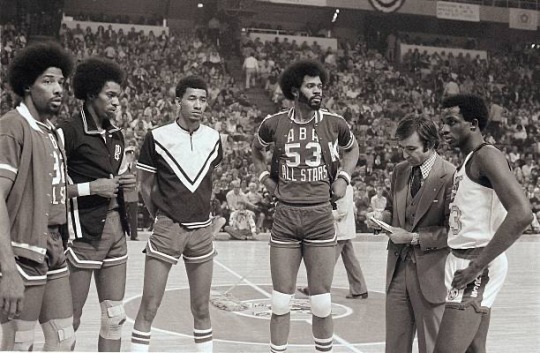



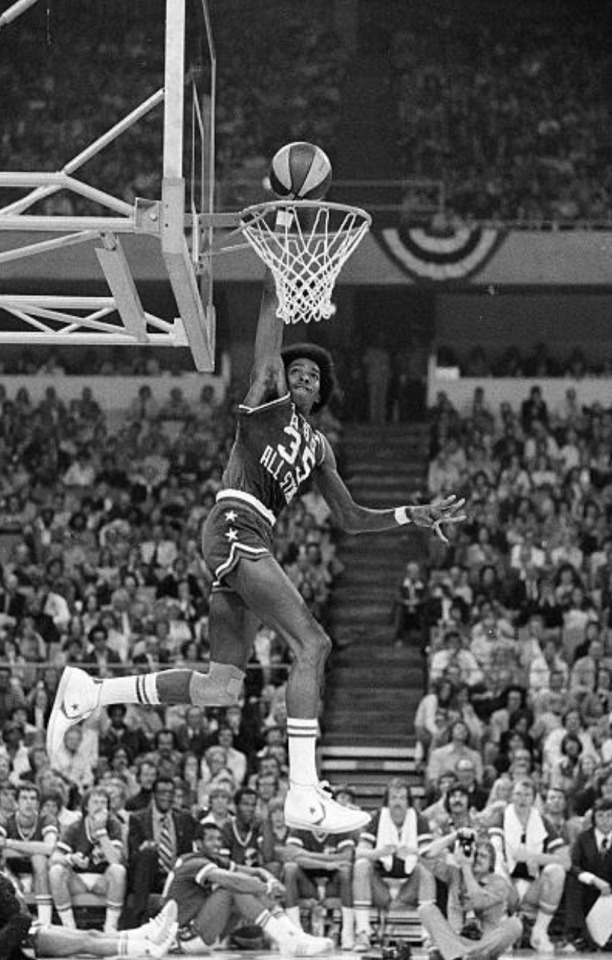
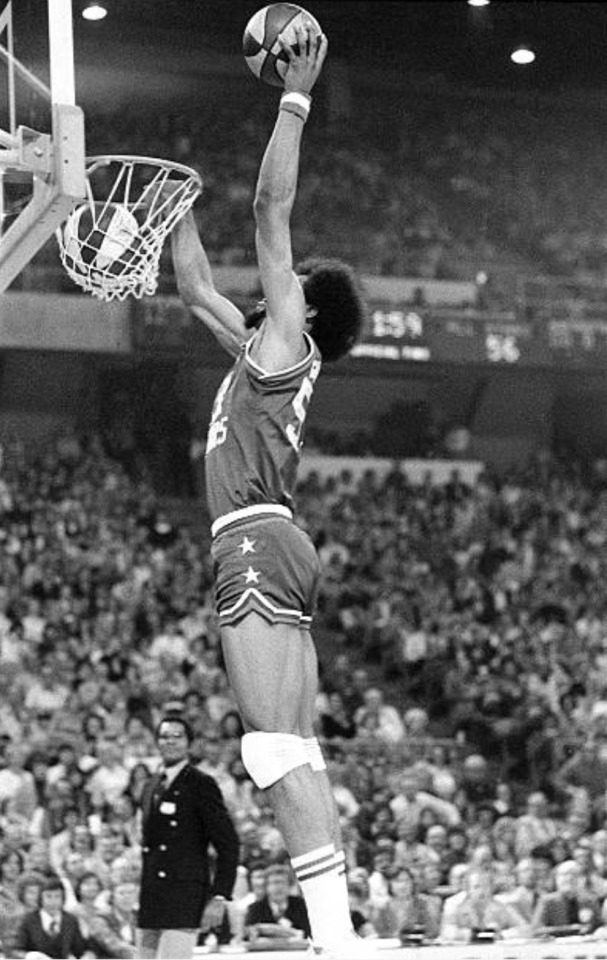
Per the rules, one dunk was to be performed standing under the basket, one taking off 10 feet from the basket, one from the right side of the basket, one from the left, and one from either of the baseline corners.
Predictably, the contest came down to Dr. J and Skywalker - the ABA’s two biggest stars. You would’ve thought Thompson was a shoe-in to win the contest, being that he played for the Denver Nuggets. His 360 dunk, the first time such a dunk had ever been recorded, should have been the exclamation point on a historic win.
However Erving stole the show and big-brothered Thompson with this legendary free throw line slam.
The build up was part of the show. Dr. J walked up to the free throw line, then slowly started walking his way across the court with very measured strides between each step. The crowd began feeling tense with anticipation. Then, after a running start, Erving lifts off one leg from the free throw line.
The aesthetic was the ABA at its finest, and arguably the league’s apex: The Doctor’s legendary hang time, the trademark red, white, and blue basketball outstretched and firmly in his grasp, and the wind blowing his majestic afro back as he slams the ball through the basket.
The Doctor blew the roof off the sold out arena and drew the biggest cheers of the night. And not just from the fans, but the players and judges too.
The All-Star Game wasn’t televised nationally, but word of the first ever dunk contest made headlines nationwide. While the eventual merger was in reach before, the contest certainly moved talks along.
The NBA would later adopt the contest themselves in 1984.
#dunkcontest#julius erving#basketball#nba#american basketball association#aba#david thompson#slam dunk#slam dunk contest#nba history#all star#all star weekend
2 notes
·
View notes
Photo
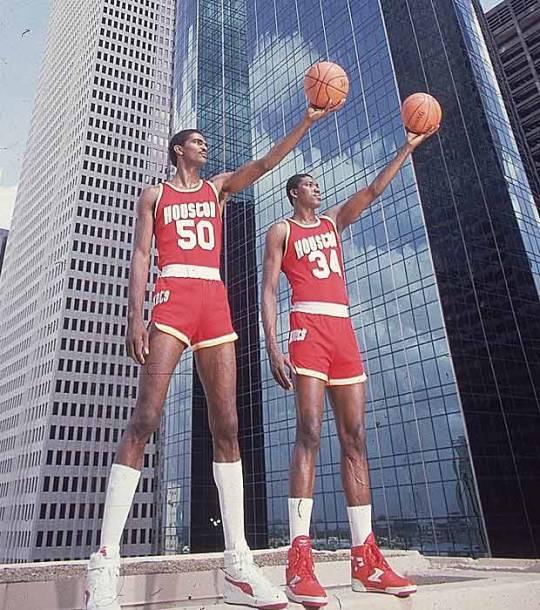
Ralph Sampson and Hakeem Olajuwon. Houston’s ’Twin Towers’ posing in front of two towers in Houston. The Houston Rockets won the #1overall pick in consecutive years in 1983 and 1984, and chose what many believed to be two generational talents in Ralph Sampson (7’4) and Hakeem Olajuwon (7’). The ‘Twin Towers’ took the league by storm from the get-go. The two averaged a combined 42.4 pts, 22.5 rebs, and 4.8 blks per game through their first two seasons. Year two is when they really came into their own. Houston took out the Kings and Nuggets in the first two rounds of the ‘86 playoffs, and found themselves in the WCF with the reigning champion ‘Showtime Lakers.’ The Lakers had their hands full with the Hakeem-Sampson duo and the Rockets vaulted to a 3-1 series lead. Sampson provided the finishing blow with a series-ending buzzer beater in the Forum to send the Rockets to the Finals. The Rockets fell to the vaunted ‘86 Celtics in 6 games, but the league was put on notice. Houston was young, dominant, and poised to take over the NBA for years to come. But that never happened. The next year, the Rockets lost three key rotation players to drugs (Lewis Lloyd and Mitchell Wiggins were suspended, and John Lucas went to rehab). Things got even worse when Sampson suffered a knee injury. The Rockets limped into the playoffs with a 42-40 record and were bounced in round two. Sampson was never the same after the knee injury. He was traded to the Golden State Warriors mid-way through the 1987 season and averaged about 16-10-2. But he had a hard time staying healthy for the rest of his career (which only lasted four more seasons) and he never averaged double-digits in points or rebounds again.
Meanwhile, the Rockets rebuilt around Hakeem and won two championships in 1994 and 1995.
8 notes
·
View notes
Photo
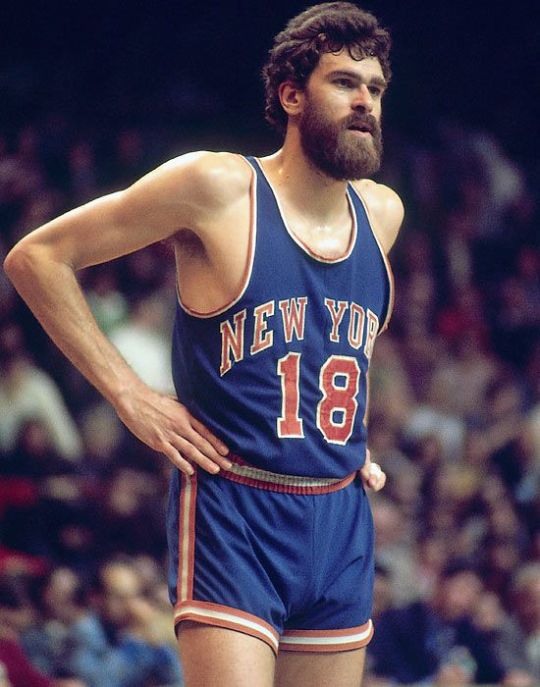
Before he was the ‘Zen Master,’ he was ‘Action’ Phil Jackson - role player extraordinaire with the New York Knicks. Jackson played with the Knicks from 1967-1977, and was a fan favorite coming off the bench. Phil wasn’t that polished offensively, but he was a hard worker on the defensive end. He averaged 6.8 points and 4.4 rebounds playing just under 18 minutes per game. While he was a part of those two Knicks title teams, he didn’t see any action for the entirety of the 1969-70 season due to recovery from spinal fusion surgery.
1 note
·
View note
Photo
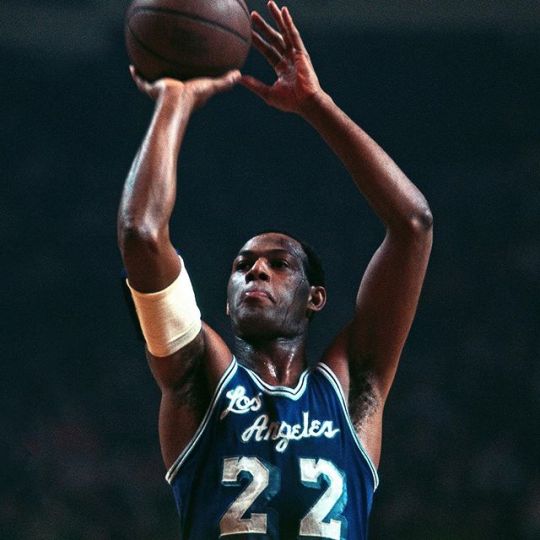
Elgin Baylor served in the U.S. Army Reserves during the 1961-62 season. He would spend his weeks living in barracks and training with fellow soldiers in Washington state, and then he’d join his Laker teammates in Los Angeles or on the road for weekend games. Baylor only played 48 games that season, but he averaged an insane 38 points, 19 rebounds, and 5 assists. He helped lead the Lakers to the Finals that year, where they fell to the Boston Celtics in 7 games. That was also the year Baylor had a record-breaking 61 points in game 5 of the Finals. That Finals scoring record stands to this day.
9 notes
·
View notes
Photo
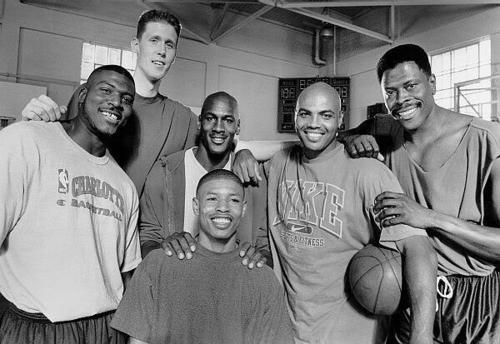
The cast of the 1996 film ‘Space Jam’: Larry Johnson, Shawn Bradley, Michael Jordan, Charles Barkley, Patrick Ewing, and Muggsy Bogues.
7 notes
·
View notes
Photo
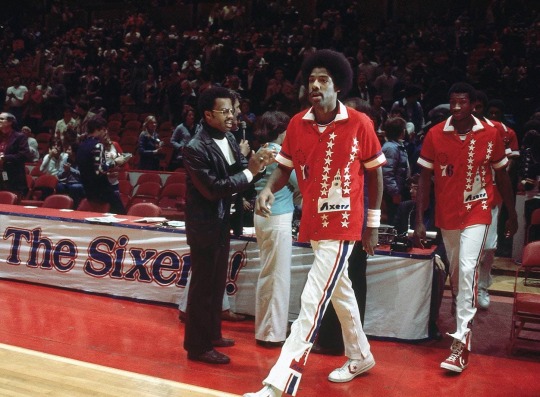
Julius Erving walks onto the court in Philly for the very first time as a member of the Sixers. Dr. J spent the first five years of his Hall of Fame career playing for the Virginia Squires and (more famously) the New York Nets of the ABA. But the ABA stood on shaky financial ground and were forced to merge with the NBA following the 1976 season. The Nets were lucky enough to be one of the four teams granted admission to the NBA. And Dr. J was promised a substantial raise by team ownership upon the move. So on paper, things were really looking up for the Nets. That is until the New York Knicks came along and demanded that the Nets pay them a $4.8 million fee for “encroaching” on the Knicks’ territory. The Nets ownership group was strapped for cash and didn’t have enough money to pay the Knicks and give Erving his promised raise. Thus, Erving elected to hold out during training camp and demanded a trade. The Nets actually offered to give the Knicks the rights to Erving straight-up in exchange for waiving the encroachment fee, but the Knicks declined the offer; which, in retrospect, is on the shortlist of the worst moves (or non-moves) in Knicks history. The Philadelphia 76ers came in and offered $3 million cash for the rights to Dr. J. The Nets accepted and the rest is history. Dr. J would lead the Sixers to four NBA Finals appearances and a title in 1983. Meanwhile, the Nets have yet to win a championship in their NBA tenure.
1 note
·
View note
Photo

Jerry West walks off the court after the Lakers lose the 1969 NBA Finals to the Boston Celtics. In this moment, West is officially 0-6 in the NBA Finals. Jerry West, nicknamed “Mr. Clutch,” turned in an NBA Finals for the ages in 1969. He averaged a ludicrous 37.9 pts, 4.7 rebs, and 7.4 asts per game for the series, including a 42-12-13 triple-double in game 7. A picture is worth a thousand words. The look of defeat jumps out of the photo. John Havlicek of the Celtics would later say, “The guy I felt terrible for in those playoffs was Jerry West. He was so great, and he was absolutely devastated. As we came off the court, I went up to Jerry and told him ‘I love you and I just hope you get a championship. You deserve it as much as anyone who has ever played this game.’ He was too emotionally spent to say anything, but you could feel his absolute and total dejection over losing.” West would go on to be named the Finals MVP of the series, despite his team losing. This remains the only time a player from the losing team has ever won a Finals MVP.
3 notes
·
View notes
Photo

Rick Barry driving past Stan Love (father of Kevin Love) in 1973.
7 notes
·
View notes
Photo

Connie Hawkins holds up the first ABA MVP trophy in 1968. He’d also lead the league in scoring and lead his Pittsburgh Pipers to the league’s inaugural title that same year. The Hawk only played two seasons in ABA. However, the only reason he joined the Pipers in the first place was because he was banned from playing in the NBA, and was in the middle of a $6 million lawsuit against the league. Hawkins was falsely accused of being a part of a point-shaving scandal in college and was effectively blackballed by the NCAA, NAIA, and the NBA over the course of nine years. The NBA eventually settled with Hawkins for $1 million and he joined the Phoenix Suns in 1969 as a 27 year old rookie. He averaged 20-9 and made four all-star teams during his time with the Suns. But by the time he reached the NBA his knees were shot and his best years were behind him. Hawkins would retire at 33, with his prime being spent on a banned list. The 6’8 Brooklyn native was the forefather of today’s power forward. His combination of height and explosiveness allowed him to impose his will above the rim. Hawkins also had catchers mitts for hands. His 11 inch hand size is good for 5th largest in NBA history and made it damn near impossible to strip the ball from him when he was driving to the basket.
0 notes
Photo

Fun fact: Hall of Famer Elvin Hayes played exactly 50,000 minutes during his career. It probably wasn’t all that random that the ticker stopped at 50,000 on the dot; but as someone who appreciates lofty round numbers, I applaud the Big E.
1 note
·
View note
Photo

Rebounding is an effort stat. You have to want the ball more than the guy next to you. And no one ever wanted a rebound more than Moses Malone. Big Mo wasn’t just a great rebounder - he was ferocious. He attacked every board like his very life depended on it. They called him ‘The Chairman of the Boards’ (incredible nickname). Mo’s 18,834 combined NBA/ABA rebounds ranks 3rd all-time behind Wilt Chamberlain and Bill Russell. And his 7,382 NBA/ABA offensive rebs is good for most ever, clearing number two on the list (Artis Gimore, 4,816 rebs) by over 2,500 offensive boards. Malone was the best player on a championship team that also featured Dr. J. His 13 all-star nods, 8 rebounding titles, and 3 MVPs adds to an already lustrious Hall of Fame resume. But my favorite Moses story has to be how he handled his jersey retirement in Philly. Moses never wanted a banner in the rafters, and actually declined the Sixers’ offer when they first approached him about it. Moses eventually agreed to the honor years later under one condition: every teammate he ever played with in his five seasons in Philly had to be recognized in some way. Philly obliged, and so the name of every one of his teammates from is Sixers tenure is outlined on the trim of the banner. Nearly 50 teammates honored alongside Moses. An all-time great gesture from an all-time great player. Rest in peace, Moses.
1 note
·
View note
Photo

On October 18, 1974, in his first game as a Chicago Bull, Nate Thurmond became the first player in recorded history to put up a quadruple-double in an overtime win against the Atlanta Hawks. Nate the Great’s final statline for the night was 22 points, 14 rebounds, 13 assists, and 12 blocks. Like I said, it was the first RECORDED quadruple-double. But it’s important to note that blocks and steals weren’t recorded until the 1973-74 season. Meaning that players like Wilt Chamberlain and Bill Russell, two legends known for their athletic prowess and defense, weren’t exactly “eligible” for this achievement. When asked about being the first, Thurmond didn’t look back on this feat as fondly as we do: “There were plenty of quadruple-doubles back in the 1960s. When I first came into the league, I played alongside with Wilt Chamberlain, and there were nights he and I were playing volleyball out there on the floor, blocking shots, deflecting passes, tipping rebounds. So it’s fairly obvious that Wilt had plenty of chances to get double figures in four categories.” On Russell, Thurmond said, “Bill Russell could also fill the stat sheet and was a threat for a quadruple-double on a nightly basis. He was a great shot-blocker and passer, besides being a tremendous overall defender.” And for himself, Thurmond said, “You think I never had a quadruple-double before 1973-74, when the NBA first started recording blocks and steals? Let me put it this way: I had 12 blocks in my quadruple-double game, and it was my 12th year in the league. That’s with two bad knees and more than 30,000 minutes pounding NBA floors, night after night. You bet I had plenty of quadruple-doubles before 1974.��� Quotes per NBA.com.
3 notes
·
View notes
Photo

Darnell Hillman stuffs Artis Gilmore in a little fro-on-fro crime. Gillmore, the all-time leader for blocks in the ABA (1,431), gets a taste of his own medicine here.
2 notes
·
View notes
Photo

Reggie Miller shooting free throws in a hostile MSG in the 1994 Eastern Conference Finals. Yes, the legendary Knicks-Pacers series of ‘94. Reggie became ‘Public Enemy No. 1’ in New York as he pieced together one of the greatest shooting performances of his career, while simultaneously waging an in-game verbal war with Knicks celebrity mascot Spike Lee. Game 5 in New York, with the series even at two games a piece, Reggie put on a shooting clinic dropping 39 points in a 93-86 rally victory to take a 3-2 series lead. Reggie did most of the damage in the clutch, dropping 25 points in the fourth quarter. Miller hit the Knicks with dagger after dagger, and then hit Spike Lee with the infamous ‘choke sign’. It was a spectacle. If you haven’t seen it, I encourage you to watch it on YouTube. It lives up, even 25 years later. The ‘Winning Time’ 30 for 30 is also a good watch, as it recounts this entire rivalry beautifully. Reggie cooled off and came back to reality in games 6 and 7. The Knicks took advantage and advanced to their first NBA Finals appearance in over 20 years, where they’d lose to the Hakeem Olajuwon-led Houston Rockets. Meanwhile, the Pacers would get their revenge in ‘95, beating the Knicks in a seven game rematch in round two. Miller put together another signature moment, dropping 8 points in 18.7 seconds in the waning moments of game one. But that’s a different post for a different day.
1 note
·
View note
Photo

The 7’1 Wilt Chamberlain marvels at the 8’1 trophy awarded to him for passing Bob Pettit as the NBA’s all-time scoring king with 20,881 points in 1966. Wilt would hold the crown for 18 years before being passed by the current leader, Kareem Abdul-Jabbar, in 1984. Wilt has also since been passed by Karl Malone, Kobe Bryant, LeBron James, Michael Jordan, and Dirk Nowitzki.
0 notes